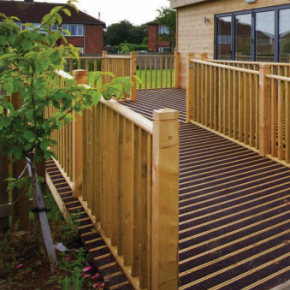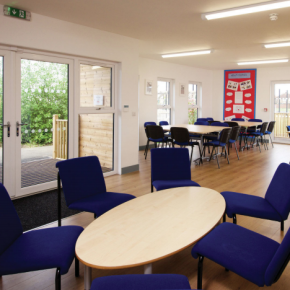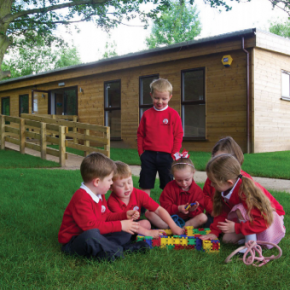
ABC&D ARTICLE: Timber education construction revolution: why is wood top of the class?
Growing pupil numbers; tightening budgets; spatial constraints; lack of dynamic teaching space – all commonly-cited concerns by school leaders and teachers.
Meanwhile, timber construction is leading a quiet revolution in education thanks to its ability to provide a dynamic, cost-effective and environmentally-friendly remedy to these challenges.
Gareth Barber, MD of The Stable Company, explains how timber construction is proving its credentials in the classroom – and passing with flying colours, in August’s edition of ABC&D magazine…
Additional learning space – useful for outdoor learning
Timber classrooms are modular, standalone facilities, meaning they can be placed almost anywhere.
Any area of the school grounds can be unlocked for valuable, extra teaching space provision. Many schools choose to place these buildings on previously derelict land, transforming what was an unused (and potentially unsightly) area into something more useful – and beautiful.
Timber-constructed classrooms are also easily situated close to school playing fields, making the buildings useful for facilitating outdoor learning – increasingly important these days.
It has been reported that three-quarters of UK children spend less time outdoors than prison inmates – so timberframed classrooms’ ability to open up and bring the outdoors in is highly valued.

High-tech timber with performance benefits
If someone said ‘modular classroom’, it may bring to mind those awful, dated prefabricated buildings. However, modern timber modular classrooms are much, much more – they are cutting-edge, contemporary learning environments that harness modern construction methods and technologies; totally bespoke to each school’s needs.
They can contain interior and exterior adaptations and design features including sliding doors, smart lighting, heat pumps and meadow roofs.
The use of canvas awnings can allow for indoor/outdoor use whatever the weather, while interior rooms can be specially designed to fulfil multiple purposes.
Modular timber construction enables the end user’s experience to be paramount. For Special Educational Needs (SEN) schools, popular solutions include well-placed handrails, accessible storage and low-level door and cupboard handles, as well as hygiene facilities.
Did you know that wood insulates fifteen times better than masonry, and 400 times better than steel? It is true – and timber has many other performance benefits over traditional building materials.
As well as being a superb natural insulator, timber is a hygroscopic material. This means it can exchange moisture with the surrounding air, fighting against humidity. Users are kept cool in summer, but warmer in winter – ensuring heating, cooling and non-renewable energy use is kept to a minimum.

Budget, time and environmentally-friendly teaching spaces
As a rule, construction projects undertaken with timber – as opposed to other traditional building materials like brick or concrete – come in at a cheaper cost.
Also, because of the off-site construction element inherent to timber, the amount of disruption to schools is drastically reduced.
Timber classrooms can be erected by a team of specialists in a matter of days or weeks. With the pollution and destruction of our planet growing ever-increasingly in importance, many schools also want to make sustainable choices where possible.
When sourced responsibly, timber has the lowest ecological resource use index of any building material; because more trees can be planted, wood is 100% renewable, and timber also stores CO2 from the atmosphere.
For schools, there is also an added bonus to making the green choice of timber construction – the projects can become eligible for external grants and funding.
Biophilic benefits
The environment that surrounds us can have a tremendous hidden effect on our physical, mental and emotional wellbeing; when harnessed for education, this can be extremely powerful.
Timber classrooms adhere to the principles of biophilic design – an approach that caters to humans’ innate desire to be surrounded by nature. This conveys physiological benefits to users.
Biophilic design benefits teachers and pupils by reducing blood pressure and stress levels, improving behaviour and school performance – even attendance. This is according to such landmark studies as School Without Stress and Wood and Human Health.
Furthermore, according to Nature Inspired Design, timber buildings can result in ‘improved mental engagement, alertness, concentration, physiological and psychological responsiveness’.
Research by Harvard University also shows that green buildings can improve cognitive function by between 61 and 101% – good news for learning. Timber construction is truly changing the game in education.
It is little wonder why: wood is providing hightech, green teaching spaces that come with time, performance, budget, space and environmental bonuses.
Latest news

26th July 2024
Enfield Speciality Doors completes world-class project for Atlas Copco HQ
A rundown office and warehouse building completely transformed into a modern headquarters for Atlas Copco has been fitted with more than 120 internal fire doors from Enfield Speciality Doors.
Posted in Access Control & Door Entry Systems, Articles, Building Industry News, Building Products & Structures, Building Systems, Case Studies, Doors, Interior Design & Construction, Interiors, Posts, Restoration & Refurbishment, Retrofit & Renovation, Security and Fire Protection, Sustainability & Energy Efficiency, Timber Buildings and Timber Products, Wooden products
26th July 2024
Abloy UK launches new white paper
Abloy UK, a leading provider of security and access control solutions, has launched a new white paper.
Posted in Access Control & Door Entry Systems, Architectural Ironmongery, Articles, Building Industry News, Building Products & Structures, Building Services, Doors, Facility Management & Building Services, Health & Safety, Information Technology, Innovations & New Products, Publications, Research & Materials Testing, Security and Fire Protection
26th July 2024
MCRMA Member Profile: David Roy, Director of Roofconsult
David Roy of MCRMA member company Roofconsult has more than 50 years’ experience to draw upon working in the building envelope sector and a unique perspective on how it has changed in that time.
Posted in Articles, BIM, Infrastructure & CAD Software, Building Associations & Institutes, Building Industry News, Building Products & Structures, Building Services, Building Systems, Cladding, Information Technology, Restoration & Refurbishment, Retrofit & Renovation, Roofs, Walls
26th July 2024
Strand: Enhancing Door Functionality and Safety
Craig Fox, Sales Director for Strand Hardware, outlines how door industry professionals might apply door limiting stays…
Posted in Architectural Ironmongery, Articles, Building Industry News, Building Products & Structures, Building Services, Doors, Facility Management & Building Services, Health & Safety, Restoration & Refurbishment, Retrofit & Renovation
 Sign up:
Sign up: